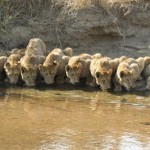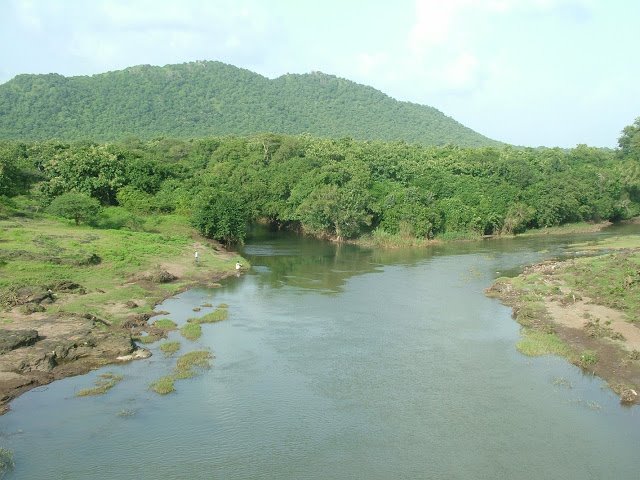 જળસ્ત્રોત:
જળસ્ત્રોત:
ગીર વિસ્તારમાં હિરણ, શેત્રુંજી, ધાતરડી, શિંગોડા, મછુન્દ્રી, ઘોડાવરી અને રાવલ એમ સાત મુખ્ય નદીઓ આવેલ છે. જેના પરનાં ચાર બંધ (ડેમ) અનુક્રમે હિરણ,મછુન્દ્રી,રાવલ અને શિંગોડા પર,આવેલ છે તે સહીત સૌથી મોટો જળસ્ત્રોત કમલેશ્વર બંધ,કે જે “ગીરની જીવાદોરી” ગણાય છે, તે મુખ્ય જળસ્ત્રોતો છે.
ભરઉનાળામાં, વન્યજીવોને લગભગ ૩૦૦ જળાશયો પર પીવાનું પાણી ઉપલબ્ધ હોય છે. જ્યારે દુકાળ કે ઓછો વરસાદ થાય ત્યારે આમાનાં મોટાભાગના જળાશયો પર પાણી હોતું નથી,અને પાણીની તંગી ગંભીર સમસ્યા ધારણ કરે છે (મુખ્યત્વે અભયારણ્યનાં પૂર્વીય ભાગમાં). ભરઉનાળાના આવા સમયે જળપુરવઠો ઉપલબ્ધ કરાવવો તે વનવિભાગના કર્મચારીઓનું મુખ્ય કાર્ય બની રહે છે.
 એશિયાઇ સિંહનો આવાસ,વિતરણ અને વસ્તી
એશિયાઇ સિંહનો આવાસ,વિતરણ અને વસ્તી
એશિયાઇ સિંહનો આવાસ ખુલ્લો વગડો અને ઝાડી ઝાંખરા વાળો વનપ્રદેશ છે.આ સિંહો એક સમયે ઉત્તર આફ્રિકા,દક્ષિણ પશ્ચિમ એશિયા અને ઉત્તરીય ગ્રીસમાં પણ જોવા મળતા હતા. હવે અંદાજે ૩૫૦ જેટલા સિંહોજ જંગલમાં બચ્યા છે,જે ફક્ત ગીરના જંગલ અને રાષ્ટ્રીય ઉદ્યાનમાં જોવા મળે છે.
આમતો જોકે ગીરનું જંગલ સારી રીતે રક્ષીત કરાયેલ છે,છતાં ક્યારેક સિંહોના શિકારની ઘટનાઓ જાણવા મળે છે.તે ઉપરાંત પાલતુ પશુઓ પરનાં હુમલાઓને કારણે ઝેર આપવાની ઘટનાઓ પણ બને છે.ક્યારેક જળપ્રલય, આગ, મહામારીઓ અન્ય કુદરતી આપદાઓ પણ તેમને નુકશાન પહોંચાડે છે.ગીર ઉદ્યાન તો પણ સિંહોને માટે લાંબા સમય સુધી અસ્તીત્વ ટકાવી રાખવા માટેનું શ્રેષ્ઠ સ્થળ બનેલું છે.
Gir, Khushboo Gujarat Ki (Hindi) -A Gujarat Tourism campaign video presented by Amitabh Bachchan.
 The Gir Forest National Park and Wildlife Sanctuary (also known as Sasan-Gir, and गिर वन) is a forest and wildlife sanctuary in Gujarat, India. Established in 1975, with a total area of 1412 km² (about 258 km² for the fully protected area (the national park) and 1153 km² for the Sanctuary), the park is located 43 km in the north-east from Somnath, 65 km to the south-east of Junagadh and 60 km to south west of Amreli.
The Gir Forest National Park and Wildlife Sanctuary (also known as Sasan-Gir, and गिर वन) is a forest and wildlife sanctuary in Gujarat, India. Established in 1975, with a total area of 1412 km² (about 258 km² for the fully protected area (the national park) and 1153 km² for the Sanctuary), the park is located 43 km in the north-east from Somnath, 65 km to the south-east of Junagadh and 60 km to south west of Amreli.
It is the sole home of the Asiatic Lions (Panthera leo persica) and is considered to be one of the most important protected areas in Asia due to its supported species. The ecosystem of Gir, with its diverse flora and fauna, is protected as a result of the efforts of the government forest department, wildlife activists and NGOs. The forest area of Gir and its lions were declared as “protected” in the early 1900s by the Nawab of the princely state of Junagadh. This initiative assisted in the conservation of the lions whose population had plummeted to only 15 through slaughter for trophy hunting.
The April 2010 census recorded the lion-count in Gir at 411, an increase of 52 compared to 2005. The lion breeding programme covering the park and surrounding area has bred about 180 lions in captivity since its inception.
Geography:
Water reservesThe seven major perennial rivers of the Gir region are Hiran, Shetrunji, Datardi, Shingoda, Machhundri, Godavari and Raval. The four reservoirs of the area are at four dams, one each on Hiran, Machhundri, Raval and Shingoda rivers, including the biggest reservoir in the area, the Kamleshwar Dam, dubbed ‘the lifeline of Gir’.
During peak summer, surface water for wild animals is available at about 300 water points. When drought hits the area following a poor rainfall, surface water is not available at a majority of these points, and water scarcity becomes a serious problem (mainly in the eastern part of the sanctuary). Ensuring the availability of water during peak summer is one of the major tasks of the Forest Department staff.
FloraMore than 400 plant species were recorded in the survey of Gir forest by Samtapau & Raizada in 1955. The Botany department of M.S. University of Baroda has revised the count to 507 during their survey. According to the 1964 forest type classification by Champion & Sheth, the Gir forest falls under “5A/C-1a—very dry teak forest” classification. Teak occurs mixed with dry deciduous species. The degradation stages (DS) sub-types are thus derived as:
1} 5/DS1-Dry deciduous scrub forest and
2} 5/DS1-Dry savannah forests (Locally known as “vidis”). It is the largest dry deciduous forest in western India.
Teak bearing areas are mainly in the eastern portion of the forest, which constitutes nearly half of the total area.
The forest is an important biological research area with considerable scientific, educational, aesthetic and recreational values. It provides nearly 5 million kilograms of green grass by annual harvesting, which is valued approximately at Rs. 50 crores (Rs. 500,000,000) (US$ 10 million). The forest provides nearly 123,000 metric tons worth of fuel wood annually. When lion count more than 100.
Wildlife:
 The count of 2,375 distinct fauna species of Gir includes about 38 species of mammals, around 300 species of birds, 37 species of reptiles and more than 2,000 species of insects.
The count of 2,375 distinct fauna species of Gir includes about 38 species of mammals, around 300 species of birds, 37 species of reptiles and more than 2,000 species of insects.
The carnivores group mainly comprises Asiatic lions, Indian Leopards, Sloth bears, Indian Cobras, Jungle cats, Striped Hyenas, Golden Jackals, Indian Mongoose, Indian Palm Civets, and Ratels. Desert cats and Rusty-spotted cats exist but are rarely seen.
The main herbivores of Gir are Chital, Nilgai (or Bluebull), Sambar, Four-horned Antelope, Chinkara and Wild boar. Blackbucks from the surrounding area are sometimes seen in the sanctuary.
Among the smaller mammals, Porcupine and Hare are common but the Pangolin is rare. The reptiles are represented by the Marsh crocodile hir Tortoise and the Monitor Lizard in the water areas of the sanctuary. Snakes are found in the bushes and forest. Pythons are sighted at times along the stream banks. Gir has been used by the Gujarat State Forest Department which adopted the Indian Crocodile Conservation Project in 1977 and released close to 1000 Marsh crocodile reared in Gir rearing centre into the Kamaleshwar lake and other reservoirs and small water bodies in and around Gir.
The plentiful avifauna population has more than 300 species of birds, most of which are resident. The scavenger group of birds has 6 recorded species of Vultures. Some of the typical species of Gir include Crested Serpent Eagle, endangered Bonelli’s Eagle, Crested Hawk-eagle, Brown Fish Owl, Indian Eagle-Owl, Rock Bush-Quail, Pygmy Woodpecker, Black-headed Oriole, Crested Treeswift and Indian Pitta. The Indian Grey Hornbill was not found in the last census of 2001.
Asiatic Lion habitat, distribution and population The Asiatic Lion’s habitat is dry scrub land and open deciduous forest. These lions were once found across northern Africa, south west Asia and northern Greece. Now there are only around 411 left in the wild and all of them are in or around the Gir Forest National Park. The first modern day count of lions was done by Mark Alexander Wynter-Blyth, the Principal of Rajkumar College, Rajkot sometime between 1948 to 1963, probably early in his tenure as the Principal during that period. Even though the Gir Forest is well protected, there are instances of Asiatic Lions being poached. They have also been poisoned for attacking livestock. Some of the other threats include floods, fires and the possibility of epidemics and natural calamities. Gir nonetheless remains the most promising long term preserve for them.
 The lion breeding programme and lion-counting The Lion Breeding Programme creates and maintains breeding centres. It also carries out studies of the behaviour of the Asiatic lions and also practices artificial insemination. One such centre has been established in the Sakkarbaug Zoo at the district headquarters of Junagadh, which has successfully bred about 180 lions. 126 pure Asiatic lions have been given to zoos in India and abroad.
The lion breeding programme and lion-counting The Lion Breeding Programme creates and maintains breeding centres. It also carries out studies of the behaviour of the Asiatic lions and also practices artificial insemination. One such centre has been established in the Sakkarbaug Zoo at the district headquarters of Junagadh, which has successfully bred about 180 lions. 126 pure Asiatic lions have been given to zoos in India and abroad.
The census of lions takes place every five years. Previously indirect methods like using pugmarks of the lion were adopted for the count. However, during the census of April 2005 (which originally was scheduled for 2006, but was advanced following the reports and controversy over vanishing tigers in India), “Block-Direct-Total Count” method was employed with the help of around 1,000 forest officials, experts and volunteers. It means that only those lions were counted that were “spotted” visually. Use of “live bait” (a prey that is alive and used as a bait) for the exercise, though thought to be a traditional practice, was not used this time. The reason believed to be behind this is the Gujarat High Court ruling of 2000 against such a use of animals.
 Gir Interpretation Zone, Devalia Gir National Park and Sanctuary does not have a designated area for tourists. However, to reduce the tourism hazard to the wildlife and to promote nature education, an Interpretation Zone has been created at Devalia within the sanctuary. Within its chained fences, it covers all habitat types and wildlife of Gir with its feeding-cum-living cages for the carnivores and a double-gate entry system.
Gir Interpretation Zone, Devalia Gir National Park and Sanctuary does not have a designated area for tourists. However, to reduce the tourism hazard to the wildlife and to promote nature education, an Interpretation Zone has been created at Devalia within the sanctuary. Within its chained fences, it covers all habitat types and wildlife of Gir with its feeding-cum-living cages for the carnivores and a double-gate entry system.
Information By: Wikipedia
PHOTOGALLERY: The Gir Forest National Park and Wildlife Sanctuary
































